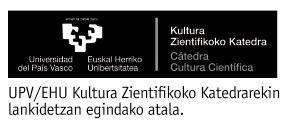“Opening the way has very good but it’s hard”
Itxasne Azparte Iraculis knew from a very young age what she wanted to do: she wanted to be a researcher. “Since I was in Bachillerato I knew I wanted to devote myself to research. It was very clear, and although it is investigated in some companies, the normal thing is to do a doctoral thesis to be a researcher. So I took that path,” he confessed.
And now he is in nanoGune, the research team of Nanomaterials, performing his thesis. The access road has been step by step: “I started studying chemistry and in the fifth course we had a subject called Material Science. To me it seemed surprising how the characteristics of the materials changed their composition. So, together with the University of Cantabria, I decided to carry out the Master of New Materials offered by the UPV”.
He does not hide his satisfaction with the development of the master, which was also awarded for his academic work. He was appointed best student of the course 2014/2015. By then he was already in nanoGune doing the thesis. In fact, in the summer between fourth and fifth year, he carried out practices in nanoGune, knowing the work that is carried out from within. “They were very useful to me to confirm that this was what I wanted to do. I told them I wanted to do a Master of New Materials, and so, I did my internship project in this field. Since then I continued to contact the director and the final work of the master I also did it in nanoGune, and the thesis is continuation of it.”
He speaks passionately about the work he is doing in the thesis. He explains that it is a question of modifying the characteristics of polymers by incorporating metallic oxides. “Metallic oxides are already used to improve the properties of polymers, but there is a physical change, that is, a layer is applied above and it is finished. My work, however, is profound, since the incorporation of oxides generates chemical interactions, which means a profound modification of the characteristics of the polymer”.
He works with Kevarra, a well-known polymer, especially because of its hardness. The incorporation of metallic oxide aims to give other characteristics: “For example, we would like to become more resistant to ultraviolet rays, as it is actually very vulnerable to ultraviolet radiation. Another of the characteristics that we want to change is conductivity, which is actually insulating, but if we turn it into conductor, we could make smart fabrics.” In addition to kevlar, it plans to experiment with other more recent polymers.
Opening Way to Open Way
The subject that is being worked on the thesis, according to Azparte, is completely new. That is very motivating on the one hand, but on the other it is difficult, because it has no where to go when you need references or want to ratify something. “Right now others are testing and releasing articles, but they are still very few. Opening the way has very good advantages, but it is hard.”
In this sense, he thanks the opinions and views he receives from his colleagues. “I am working with microscopy and other fields, because I need them to characterize the material I make, and I find very useful everything they tell me. I have not looked to confirm that what I am doing is fine, but I have the help of others.”
He still has his first year of thesis, so he has not thought too much in the future. However, it is clear you would like to continue investigating: “To be able to be I would like to go abroad, for a couple of years, or to do the postgraduate.” What you do know is that it is difficult, so if in some company you are offered a job you would. But he has hope: “When you’re investigating, you’re doing a lot of relationships with people from foreign research groups, and someone knows if there’s going to come some chance…” It has desire and desire.
Itxasne Azparte Iraculis (Amorebieta, 1991). Degree in Chemistry from UPV/EHU in 2014. Later he completed the Master of New Materials taught by UPV/EHU and the University of Cantabria, obtaining the award for the best student of the course 2014/2015. In September 2015, he obtained a pre-doctoral grant from the Basque Government and began his doctoral thesis "Modification of polymers through vapor phase infiltration" at the CIC nanoGUNE research centre.







